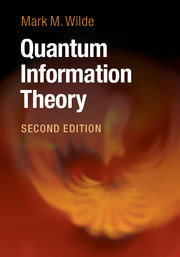Book contents
- Frontmatter
- Contents
- Preface to the Second Edition
- Preface to the First Edition
- How To Use This Book
- Part I Introduction
- Part II The Quantum Theory
- Part III Unit Quantum Protocols
- 6 Three Unit Quantum Protocols
- 7 Coherent Protocols
- 8 Unit Resource Capacity Region
- Part IV Tools of Quantum Shannon Theory
- Part V Noiseless Quantum Shannon Theory
- Part VI Noisy Quantum Shannon Theory
- Appendix A Supplementary Results
- Appendix B Unique Linear Extension of a Quantum Physical Evolution
- References
- Index
6 - Three Unit Quantum Protocols
from Part III - Unit Quantum Protocols
Published online by Cambridge University Press: 16 February 2017
- Frontmatter
- Contents
- Preface to the Second Edition
- Preface to the First Edition
- How To Use This Book
- Part I Introduction
- Part II The Quantum Theory
- Part III Unit Quantum Protocols
- 6 Three Unit Quantum Protocols
- 7 Coherent Protocols
- 8 Unit Resource Capacity Region
- Part IV Tools of Quantum Shannon Theory
- Part V Noiseless Quantum Shannon Theory
- Part VI Noisy Quantum Shannon Theory
- Appendix A Supplementary Results
- Appendix B Unique Linear Extension of a Quantum Physical Evolution
- References
- Index
Summary
This chapter begins our first exciting application of the postulates of the quantum theory to quantum communication. We study the fundamental, unit quantum communication protocols. These protocols involve a single sender Alice and a single receiver Bob. The protocols are ideal and noiseless because we assume that Alice and Bob can exploit perfect classical communication, perfect quantum communication, and perfect entanglement. At the end of this chapter, we suggest how to incorporate imperfections into these protocols for later study.
Alice and Bob may wish to perform one of several quantum informationprocessing tasks, such as the transmission of classical information, quantum information, or entanglement. Several fundamental protocols make use of these resources:
1. We will see that noiseless entanglement is an important resource in quantum Shannon theory because it enables Alice and Bob to perform other protocols that are not possible with classical resources only. We will present a simple, idealized protocol for generating entanglement, named entanglement distribution.
2. Alice may wish to communicate classical information to Bob. A trivial method, named elementary coding, is a simple way of doing so and we discuss it briefly.
3. A more interesting technique for transmitting classical information is superdense coding. It exploits a noiseless qubit channel and shared entanglement to transmit more classical information than would be possible with a noiseless qubit channel alone.
4. Finally, Alice may wish to transmit quantum information to Bob. A trivial method for her to do so is to exploit a noiseless qubit channel. However, it is useful to have other ways for transmitting quantum information because such a resource is difficult to engineer in practice. An alternative, surprising method for transmitting quantum information is quantum teleportation. The teleportation protocol exploits classical communication and shared entanglement to transmit quantum information.
Each of these protocols is a fundamental unit protocol and provides a foundation for asking further questions in quantum Shannon theory. In fact, the discovery of these latter two protocols was the stimulus for much of the original research in quantum Shannon theory. One could take each of these protocols and ask about its performance if one or more of the resources involved is noisy rather than noiseless. Later chapters of this book explore many of these possibilities.
- Type
- Chapter
- Information
- Quantum Information Theory , pp. 185 - 206Publisher: Cambridge University PressPrint publication year: 2017

